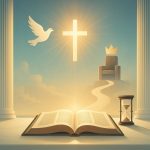| Host: | Brant Berglin |
|---|---|
| Guests: | Dave Thomas and Alden Thompson |
| Quarter: | The Book of Revelation |
| Lesson: | 11 |
| Sabbath: |
Opening Question
Should we consider natural disasters on this earth “acts of God”?
Introduction
Revelation 15 pictures the saints of God, and introduces the seven last plagues and the fall of Babylon. The plague motif here recalls God’s people in Egypt and their deliverance, as well as their exile in Babylon and deliverance there (referenced in the 6th plague). The plagues are a final preparation for the deliverance of God’s people in the language of His deliverance in the past. If you know how God has rescued in history, you will see him doing it again.
The Text:
Revelation 15:1-8
Once again, the Most Holy Place (temple of the tabernacle of the testimony) is open, but now angels are coming out, and nobody can enter it. This suggests that the priestly intercession is complete, and that as the priest came out of the temple with blood to finally rid the temple of sins gathered through the year, so Christ has finished his atonement for the sanctuary.
God sends the plagues as a response to His final judgement, and they fall on the seat of the beast and his throne. There were 10 plagues in Egypt; the first three fell on the whole land, including Goshen and God’s people. But after this, the next seven fell only on Egypt, or God made an allowance for all to be saved from it (10th plague).
Throughout both Old and New Testaments, this idea is presented, but many don’t accept an angry God who is supposed to be all love. How do you reconcile these two ideas? How would you describe God’s “wrath” or “anger”?
Revelation 16:1-11
Unlike the seals and trumpets, we do not see a lengthening of time before the last seal or trumpet (almost like God is delaying the end in His mercy). These continue one after the next. The word for “bowls” here is the same as that used in 5:8 to describe the bowls filled with incense which are the prayers of the saints. The final judgements of God poured out, then, are related to the prayers of God’s people; perhaps another reference to the 5th seal.
- Those who receive the mark of the beast receive a painful “mark” or sore. Thus the sore is directly related to the mark, showing that if you receive the mark of the beast, it’s really a painful thing.
- The sea in Revelation represents the people of earth, and now everything is turned to blood. The blood of the saints was spilled, now in the 2nd and 3rd plagues turn all liquid to blood.
- The fresh water, representing spiritual life, is now undrinkable, too. Verse 5-7 explain why God gives blood to drink, and also a clue as to how to understand these plagues more broadly: God is giving the people what they have asked for, only now they see it in its true light. Much like Israel crying out for meat in the wilderness and God giving them so much quail it “came out their nostrils,” so God is giving the wicked exactly what they want. They’ve wanted blood to drink, so God is giving it to them. Everything is now blood!
- As in Ezekiel 7-9, where Israel was worshipping the sun with their back to the temple of God, we now see that the sun that people have worshipped is made too strong for humans to handle. It scorches them. They asked for the sun (a hint of the “Sun-day”?) and now they get it in abundance and it scorches them.
- Verses 9-10 show the beast’s kingdom itself falling into darkness. They have taken the light of God away, and now their own kingdom is shown to be nothing but emptiness. There is no light or truth in it. It causes people much pain.
- The 6th plague is a fascinating one. The drying up of the River Euphrates, the support for the city of Babylon, recalls Cyrus’—called a “messiah” in Isaiah—capture of Belteshazzar’s (grandson of Nebuchadnezzar) throne by diverting the river under the city. Cyrus was the King that let Israel go back to their homeland, and so will Christ when He comes back. We see three frogs mimicking the three angels in ch. 14 summon people to war. The final battle of “Armageddon” isn’t a war for oil in the Middle East or a battle for an earthly kingdom; the word comes from “har”=mountain, and “Megiddo”=the city at the base of Mt. Carmel. This is the Elijah battle with the prophets of Baal, that is, the final showdown to decide who is god and worthy of worship. In 1 Kings 18, however, God rains down fire; here, fire will probably come from the False Prophet (see Rev. 13), and will deceive many. Embedded parenthetically in this plague is a reminder of Christ’s return, a call to Laodicea: stay awake and stay clothed!
- The final plague brings the fall of Babylon just as Jericho fell at the last trumpet call.
What evidence do you see for interpreting the plagues . . . literally? . . . symbolically? What does God gain by sending the plagues, from which nobody repents? How does this event parallel Pharaoh’s response to God, when the text says that both Pharaoh hardened his own heart, and that God hardened his heart?
Closing Comments
These final plagues are good news for the people of God because they prepare the way for His coming. With Babylon’s fall, God’s people are finally free from the clutches of evil.





